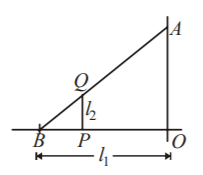1. If $$xy = {a^2}$$ and $$S = {b^2}x + {c^2}y$$ where $$a,\,b$$ and $$c$$ are constants then the minimum value of $$S$$ is :
A.
$$abc$$
B.
$$bc\sqrt a $$
C.
$$2abc$$
D.
none of these
Answer :
$$2abc$$
2. The number of tangents to the curve $${x^{\frac{3}{2}}} + {y^{\frac{3}{2}}} = 2{a^{\frac{3}{2}}},\,a > 0,$$ which are equally inclined to the axes, is :
A.
2
B.
1
C.
0
D.
4
Answer :
1
3. Let $$f\left( x \right) = {\tan ^{ - 1}}\left\{ {\phi \left( x \right)} \right\},$$ where $$\phi \left( x \right)$$ is $$m.i.$$ for $$0 < x < \frac{\pi }{2}.$$ Then $$f\left( x \right)$$ is :
A.
increasing in $$\left( {0,\,\frac{\pi }{2}} \right)$$
B.
decreasing in $$\left( {0,\,\frac{\pi }{2}} \right)$$
C.
increasing in $$\left( {0,\,\frac{\pi }{4}} \right)$$ and decreasing in $$\left( {\frac{\pi }{4},\,\frac{\pi }{2}} \right)$$
D.
none of these
Answer :
increasing in $$\left( {0,\,\frac{\pi }{2}} \right)$$
4. The function $$f\left( x \right) = 1 + x\left( {\sin \,x} \right)\left[ {\cos \,x} \right],\,0 < x \leqslant \frac{\pi }{2}$$ (where [.] is G.I.F.)
A.
is continuous on $$\left( {0,\,\frac{\pi }{2}} \right)$$
B.
is strictly increasing in $$\left( {0,\,\frac{\pi }{2}} \right)$$
C.
is strictly decreasing in $$\left( {0,\,\frac{\pi }{2}} \right)$$
D.
has global maximum value $$2$$
Answer :
is continuous on $$\left( {0,\,\frac{\pi }{2}} \right)$$
5. A lamp of negligible height is placed on the ground $${l_1}\,m$$ away from a wall. A man $${l_2}\,m$$ tall is walking at a speed of $$\frac{{{l_1}}}{{10}}\,m/s$$ from the lamp to the nearest point on the wall. When he is midway between the lamp and the wall, the rate of change in the length of this shadow on the wall is :
A.
$$ - \frac{{5{l_2}}}{2}\,m/s$$
B.
$$ - \frac{{2{l_2}}}{5}\,m/s$$
C.
$$ - \frac{{{l_2}}}{2}\,m/s$$
D.
$$ - \frac{{{l_2}}}{5}\,m/s$$
Answer :
$$ - \frac{{2{l_2}}}{5}\,m/s$$
6. If the equation $${a_n}{x^n} + {a_{n - 1}}{x^{n - 1}} + ..... + {a_1}x = 0,\,{a_1} \ne 0,\,n \geqslant 2,$$ has a positive root $$\alpha $$ then the equation $$n{a_n}{x^{n - 1}} + \left( {n - 1} \right){a_{n - 1}}{x^{x - 2}} + ..... + {a_1} = 0$$ has a positive root which is :
A.
greater than $$\alpha $$
B.
smaller than $$\alpha $$
C.
greater than or equal to $$\alpha $$
D.
equal to $$\alpha $$
Answer :
smaller than $$\alpha $$
7. The function $$f\left( x \right) = {\sin ^4}x + {\cos ^4}x$$ increases if :
A.
$$0 < x < \frac{\pi }{8}$$
B.
$$\frac{{\pi }}{4} < x < \frac{{3\pi }}{8}$$
C.
$$\frac{{3\pi }}{4} < x < \frac{{5\pi }}{8}$$
D.
$$\frac{{5\pi }}{8} < x < \frac{{3\pi }}{4}$$
Answer :
$$\frac{{\pi }}{4} < x < \frac{{3\pi }}{8}$$
8. The area bounded by the axes of reference and the normal to $$y = {\log _e}x$$ at the point $$\left( {1,\,0} \right)$$ is :
A.
$$1{\text{ uni}}{{\text{t}}^2}$$
B.
$$2{\text{ uni}}{{\text{t}}^2}$$
C.
$$\frac{1}{2}{\text{ uni}}{{\text{t}}^2}$$
D.
none of these
Answer :
$$\frac{1}{2}{\text{ uni}}{{\text{t}}^2}$$
9. A function $$y = f\left( x \right)$$ has a second order derivative $$f''\left( x \right) = 6\left( {x - 1} \right).$$ If its graph passes through the point (2,1) and at that point the tangent to the graph is $$y = 3x - 5,$$ then the function is
A.
$${\left( {x + 1} \right)^2}$$
B.
$${\left( {x - 1} \right)^3}$$
C.
$${\left( {x + 1} \right)^3}$$
D.
$${\left( {x - 1} \right)^2}$$
Answer :
$${\left( {x - 1} \right)^3}$$
10. $$f\left( x \right) = \frac{{\log \left( {\pi + x} \right)}}{{\log \left( {e + x} \right)}}{\text{ is :}}$$
A.
increasing in $$\left[ {0,\,\infty } \right)$$
B.
decreasing in $$\left[ {0,\,\infty } \right)$$
C.
decreasing in $$\left[ {0,\,\frac{\pi }{e}} \right]$$ & increasing in $$\left[ {\frac{\pi }{e},\,\infty } \right)$$
D.
increasing in $$\left[ {0,\,\frac{\pi }{e}} \right]$$ & decreasing in $$\left[ {\frac{\pi }{e},\,\infty } \right)$$
Answer :
decreasing in $$\left[ {0,\,\infty } \right)$$
